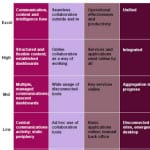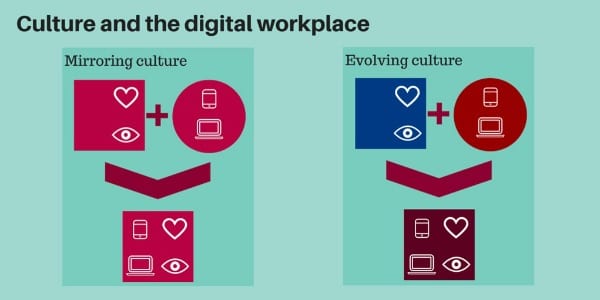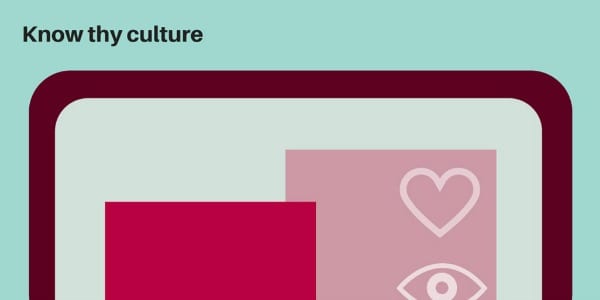What is the relationship between organizational culture and the digital workplace?

The digital workplace is complex. Organizational culture is complex. The two seem deeply intertwined, but how can one shape the other? This is the first of a two-part series exploring the question.
One of my favourite classic children’s story books is “Alice’s Adventures in Wonderland”. There is nothing quite like the experience of joining hands with Alice to venture down the rabbit hole, exclaiming “Curiouser and curiouser!” at the strange wonders before you, encountering the roll call of wonderful creatures, experimenting with the various potions and going head to head with the Queen of Hearts.
It’s also a fantastic metaphor for real life.
And so, upon embarking on a piece of research exploring the relationship between organizational culture and the digital workplace, I found myself frequently thinking of Alice, the White Rabbit, and – more than once – the Mad Hatter.
The topic also brought to mind the mistake of looking too closely at the sun: it’s good to know it’s there and that it presides over all we do, but look at it too closely and your vision will likely burst into fragments.
This is all a roundabout way of saying that once you really delve into the fascinating topic of organizational culture, it can feel like a lot like Wonderland.
Let’s talk about culture
But why look at it in the first place? A quick flick back through some recent DWG content reflects an increasing need to understand “culture” within the context of the digital workplace:
- A recent Member Meeting in London involved an impromptu breakout session focused on “Culture and change management”, triggered by common challenges cited by people in the room. A similar meeting held in November last year saw a member talk about how her team was looking at culture in parallel to their digital workplace programme.
- A consultancy engagement I took part in last year revealed that one of DWG’s clients was concerned that their flexible working policy was having an adverse impact on their culture; they wanted to explore how their digital workplace could help them retain their highly valued sense of “community”.
- DWG CEO Paul Miller has recently blogged about how you can recreate IKEA’s culture of “fika” in the digital workplace, inspired by a workshop he ran at their headquarters.
- DW24 Innovation Spotlight sponsor Jostle has also shared two case studies where a social intranet was used to support cultural change.
Which is to say: culture matters. Whether you’re seeking to change it, sustain it, save it or create it, culture plays a role within our organizations – and within the digital workplace – that should not be underestimated.
Lessons in culture and the digital workplace
My research is ongoing and will lead to a briefing paper for DWG’s members that delves deeper into and expands upon the themes presented here. But in the spirit of collaboration, learning and challenge, it was agreed that I would write a two-part blog post early on in the research, to help give shape to some of our thoughts and to invite debate. After all, the process of blogging can be as much about learning for the writer as for the reader. While this first post frames the topic and lays its theoretical foundations, the second will aim to share some cultural facilitators and blockers when it comes to building an effective digital workplace.
So, from under the piles of theory, frameworks and interview notes, emerge four key areas that should be considered as laying the foundations for a wider, deeper and practical discussion about organizational culture and the digital workplace.
What is “culture”?
Before we get down to the nitty gritty, there’s a pretty fundamental question that needs to be answered: What exactly do we mean by “culture”?
At its most basic level, organizational culture is about “the way we do things”. It’s manifested through the aggregation of elements such as individuals’ actions, processes, the relationships between people and leadership style. As Digital Workplace Strategist and Consultant Chris Tubb described to me: ”It’s the social norms that govern people’s behaviour.” It’s an organization’s personality, and what makes each organization unique and identifiable as that organization.
At a more complex level, organizational culture becomes that burst of fragments. Is there one overarching culture for the entire organization, such as IKEA’s “fika”? Are there pockets of culture within that, dependent on factors such as profession, leadership style of a team, localized hiring practices? Is there no one consistent culture that spans the whole organization, but rather multiple cultures? The truth is that the answers to these questions will vary from organization to organization. The real question is how your own organization’s culture and its variants are formed, the strength of it and its relationship to your digital workplace.
Now, I could launch into a detailed exposition that lists all the various theories and models of organizational culture, going into graphic detail about the merits and cons of each. But I’m not sure how much value there would be in that, and I need to make sure my practitioner side keeps my academic alter-ego in check. So, for now, here are two key elements that combine to create an organization’s culture: values and practices.

Just as with people, an organization (or team) will have a set of values driving its decision-making and actions – the essence of “who” it is. It’s how Zappos demonstrates its value “Embrace and drive change”, through challenging processes, perspectives and opinions. Or how Google demonstrates “Focus on the user”, through the way it displays advertising in its search results. This is why culture change – or emulation – can be so hard. At its core, it can be about trying to mutate the DNA of an organization.
What’s the relationship between the digital workplace and culture?
Just as every digital workplace is unique to that organization, so also is each culture. But what’s the relationship between the two?
Through the research carried out so far, a truism has emerged: an effective digital workplace is one that mirrors the culture of an organization.
This is why some organizations appear seamlessly to integrate collaboration tools or enterprise social networks, while others struggle – it’s because that way of working is already natural to the former, while not yet embedded culturally within the latter.
At the same time, purposely building a digital workplace at odds with a culture can help create a values crisis, as it threatens the way things are done and shows the art of the possible. Done in the right way – with leadership on board, and employing change management and user research – this can help morph practices and, in time, the values of an organization.

“Culture” or “change management”?
As our research progresses, one of the “rabbit holes” we find ourselves falling down is the debate as to whether what we are really interested in is change management – a topic about which DWG has just released a report. After some deep thought, I think the two are intimately related and aren’t necessarily mutually exclusive.
The crux of it is that we often don’t think about culture until it’s either under threat or proving to stand in the way of achieving a vision. Or both. And often, once you’ve reached this point, you’re likely to be looking for quick solutions to address a failing initiative rather than a long-term cultural change programme.
This is why the question “What is culture?” is so important.
Case study 1: Change on a small scale
If you state that one of your challenges is your culture, do you mean that the deeply held values of the organization are standing in the way of your project? If so, it may be time to take another look at whether your programme is truly aligned with the business.
For example, pushing a collaboration platform that’s great at supporting an open and transparent way of working may not work in a heavily regulated, risk-averse company. But that same company may also have a strong culture of professional development. Here, a well-designed e-learning environment, supported by a mobile app that provides just-in-time learning, may be just the trick. “Change” then becomes about training, communication and possibly also improved processes.
Case study 2: Change on a large scale
On the other hand, is there a wider recognition that the culture of the organization is damaging to its sustainability? This may well be an opportunity for you to work with other departments under the auspices of an organizational transformation programme, to evolve it into something more positive.
Consider, for example, a company whose culture has become characterized by mistrust in leadership. HR, senior management, Internal Communications, IT, the Digital Workplace team can together take a look at the cultural values that the company wants to move towards – say, approachable and open management. In this instance, “change” then becomes about building a holistic, far-reaching programme, in which the digital workplace is one element that helps leadership demonstrate those new values. Because ultimately, if an organization’s culture is weak or broken, it’s not going to be fixed by a new mobile app alone.
If neither of these “mirror” or “evolve” examples ring true, it may be time to break down what you mean by “culture” a little; language is, after all, important. Which specific cultural elements are proving an issue? What needs to change? Is it leadership? Are old habits too deeply ingrained and proving difficult to change? Is it a specific department or demographic? What are the elements that are positive and that you can use in your favour? Get beyond “culture” as a shorthand and break down what the issue really is.
Know thyself?
What all this comes down to is: know thyself. Frameworks that help identify different cultural types for organizations abound, each with their own specific dimensions that help you plot out different types of organizational characteristics. And each has their own implication for how to go about building an effective digital workplace.
But what has emerged as we embark on our reading is that there shouldn’t be one distinct culture that is considered to be more conducive to a digital workplace programme than any other. Yes, many of us would like to think that our organization could have that same enticing, informal, fun culture so often associated with Silicon Valley. And there are universal cultural elements that will better lend themselves to a digital workplace that meets your businesses needs than others.
But ultimately “cultural readiness” starts with looking at your organization, at the teams within it, at yourself and those around you, warts and all. It starts with looking at and through the looking glass, identifying what’s good and working in your favour, what could be better, and how a digital workplace can support and help evolve those cultural elements that the organization wants to be stronger.

Back up the rabbit hole, then through the looking glass
And so, after falling down the rabbit hole, these are the key lessons learned so far:
- Culture, at its core, is comprised of values and practices.
- The digital workplace can mirror your organization’s culture, or – as part of a wider initiative – help evolve it.
- The role of culture within any change management initiative will depend on what impact your culture is having on your attempts to achieve your vision; is it helping or hindering?
- Ultimately, you need to look into the looking glass. What is your organization’s overarching culture, if it has one? If not, what are the different cultures existing side by side? What are the pockets within that? Identify the good and the bad, so that you can then plan out the right interventions.
Next time…
The next phase of my research is going to be looking at some of the universal cultural elements that can impact a digital workplace, to build on the conceptual groundwork laid above.
Until then, please do join me in the comments section below to continue the conversation.
Digital workplace mapping
 What is the state of your Digital Workplace right now – where are the strengths and weaknesses? If you improve, what will you measure progress against?
What is the state of your Digital Workplace right now – where are the strengths and weaknesses? If you improve, what will you measure progress against?
Through work with Microsoft, IBM, KPMG, Citi, Johnson & Johnson and Fujitsu, DWG has developed a seven-point framework to map and measure the performance of an organizations’ Digital Workplace.
Categorised in: Digital workplace, Organizational culture



